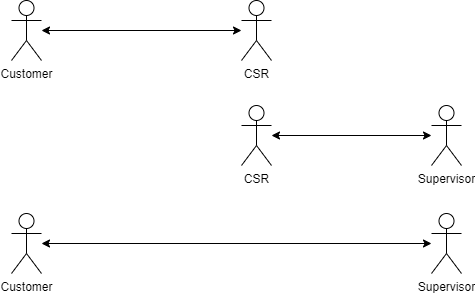
Transfers
Warm transfers
There are two types of transfers an agent can perform, warm and blind. The following image shows a typical flow of a warm transfer.
After a customer is connected to a customer service representative (CSR) and they work to resolve the customer’s issue. At some point the customer wants to do something that the CSR doesn’t have the knowledge or ability to do. In order to help the customer the CSR needs to transfer the call to another agent or to a supervisor that can handle the issue. With a warm transfer, the CSR has the opportunity to discuss the current interaction about the customer with the agent or supervisor that will continue the call. The case and call are transferred to the agent so they can pick up exactly where the first agent left off.
Pega Customer Service uses a “push” mechanism, rather than “pull” to execute the transfer. This means that when the integrated voice data transfer happens, the receiving agent may not be using Pega and therefore, are able to take the call but unable to take the associated interaction and service cases. This results in the interaction and service cases staying open that you will need to monitor and resolve.
Blind transfers
The other way to use transfers is via a blind transfer. The following image shows the sequence of a blind transfer.
A blind transfer starts off the same as a warm transfer. During an interaction with a customer, a CSR receives a request that he cannot fulfil. When doing a blind transfer the CSR reassigns the call to a an appropriate queue. For example, maybe the customer would like to speak in Spanish and the CSR does not know Spanish. The CSR can reassign the customer to a Spanish queue so that the customer has a better experience. In this instance, the CSR doesn’t not get to talk with the CSR who takes the call, but they can provide information to the new CSR in the notes before the transfer. The new CSR sees these notes as part of the screen pop they receive for the incoming call.
This Topic is available in the following Modules:
- Call transfers v2
- Call transfers v3
If you are having problems with your training, please review the Pega Academy Support FAQs.
Want to help us improve this content?

